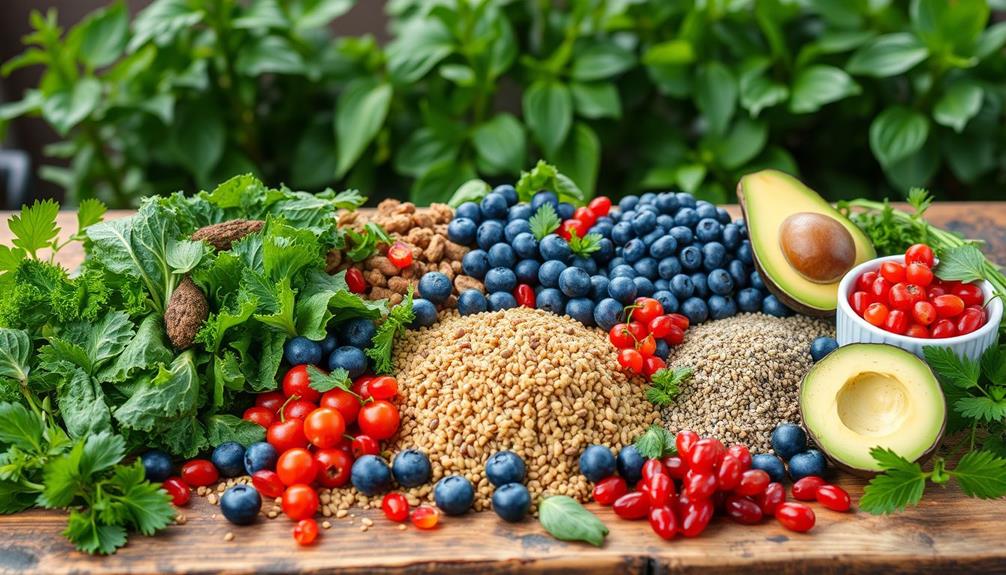Plants have incredible adaptations that help them survive in various environments. For instance, succulents store water in modified leaves, thriving in dry conditions. Their unique root systems tap into water and nutrients, ensuring stability and support. Some plants even form partnerships with fungi to boost nutrient absorption. Climbing plants use tendrils for support, reaching for sunlight in crowded spaces. Others, like carnivorous plants, attract and trap prey to supplement their nutrient intake. These fascinating adaptations showcase nature's creativity and resilience. Discover even more remarkable strategies that plants employ to thrive in challenging conditions.
Key Takeaways
- Plants exhibit unique root systems, such as taproots and mycorrhizal associations, enhancing water and nutrient uptake in diverse environments.
- Specialized leaf structures, like succulents and needle-like leaves, minimize water loss and store moisture, enabling survival in arid conditions.
- Diverse reproductive strategies, including double fertilization and seed dispersal mechanisms, promote genetic diversity and successful colonization across various habitats.
- Climbing adaptations, such as tendrils and aerial roots, allow plants to access sunlight and optimize resource utilization in competitive environments.
- Environmental stress responses, including stomata regulation and protective flavonoids, enable plants to maintain vital processes despite challenging conditions.
Unique Root Systems
In the plant kingdom, unique root systems play a crucial role in survival and adaptation. You'll notice that different plants have evolved various root types to thrive in their environments. For instance, taproots, like those found in carrots and dandelions, dig deep into the soil to access water and nutrients, providing stability and drought resistance.
These adaptations not only guarantee the plants' survival but also promote physical health through active engagement in their ecosystems. On the other hand, fibrous roots, commonly seen in grasses, spread horizontally. This helps improve soil structure, prevents erosion, and efficiently absorbs surface moisture.
Adventitious roots are particularly fascinating. You might see them in plants like corn and ivy, where roots grow from stems or leaves. This adaptation allows these plants to anchor securely while accessing additional nutrients and moisture in their surroundings.
Some plants further enhance their root systems through mycorrhizal associations, forming partnerships with fungi that boost nutrient uptake, especially phosphorus. Finally, consider the banyan tree, which develops prop roots that extend from its branches to the ground, providing essential structural support in unstable soils.
Each of these unique root systems illustrates how plants have adapted to their specific niches, guaranteeing their survival in diverse ecosystems.
Specialized Leaf Structures

While many plants rely on standard leaf structures, others have evolved specialized adaptations that enhance their survival in challenging environments. For instance, the ability to forage for wild plants can complement these adaptations, as some species aren't only resilient but also provide nutritional benefits when incorporated into diets, such as through foraging recipes and preparation.
Take succulents like aloe and jade, for example. Their specialized leaf structures are designed to store water and minimize transpiration, allowing them to thrive in arid conditions. Similarly, conifers, such as pines, have needle-like leaves that reduce surface area and water loss, making photosynthesis efficient even in cold climates.
You'll also notice the waxy cuticle on many leaves, acting as a protective barrier against desiccation and pathogens. This feature boosts the survival chances of plants across diverse habitats.
Some fascinating adaptations include the carnivorous sundew, which has modified leaf surfaces with glandular hairs. These hairs secrete sticky substances that capture and digest prey, providing essential nutrients.
Epiphytic orchids showcase another example, with leaves adapted into thick, water-retaining structures. These help the plants absorb moisture from the air in their forest canopy homes.
Each of these specialized leaf structures illustrates the incredible ways plants adapt to their environments, ensuring their survival and thriving in various ecosystems.
Reproductive Strategies

Plants showcase a fascinating array of reproductive strategies that guarantee their survival and propagation across diverse environments. One key aspect of these strategies is the haplodiplontic lifecycle, which alternates between haploid gametophyte and diploid sporophyte stages.
In vascular plants, the sporophyte phase dominates, securing effective reproduction. Additionally, just as diversifying investment portfolios can enhance financial security, plants have evolved complex reproductive mechanisms to adapt to their surroundings and maintain resilience in fluctuating environments, particularly through strategic investment in precious metals.
Here are three intriguing reproductive strategies:
- Double Fertilization: In angiosperms, one sperm fertilizes the egg to form a zygote, while another sperm fuses with two polar nuclei to create a triploid endosperm, which nourishes the developing seed.
- Pollination Adaptations: Many plants have evolved unique traits, like nectar guides and specific flower shapes, to attract particular pollinators. This targeted pollination boosts their reproductive success.
- Seed Dispersal Mechanisms: Plants utilize various strategies like wind, water, or animals to disperse their seeds. This not only helps in colonizing new areas but also promotes genetic diversity, which is vital for species survival.
These strategies illustrate the remarkable ways plants adapt to their environments and maintain their continued existence.
Drought Resistance Mechanisms

Surviving in arid environments requires a set of remarkable adaptations, and drought-resistant plants showcase how nature has equipped them to thrive despite limited water availability. These plants employ various mechanisms to guarantee their survival.
| Adaptation Type | Description | Example Plant |
|---|---|---|
| Water Storage | Specialized tissues store water for long periods | Succulents |
| Waxy Cuticle | Thick cuticle minimizes water loss | Xerophytes |
| Deep Root Systems | Roots tap into groundwater inaccessible to others | Mesquite tree |
| CAM Photosynthesis | Stomata open at night to reduce water loss | Pineapple, cactus |
| Leaf Modifications | Smaller leaves or spines reduce surface area | Cacti |
These adaptations enhance drought resistance and allow plants to maintain their vascular systems efficiently, even when water is scarce. For instance, CAM enables some plants to photosynthesize effectively while minimizing transpiration during the hottest parts of the day. Additionally, leaf modifications limit water loss, further supporting survival in harsh climates. By employing these strategies, drought-resistant plants truly exemplify the resilience of life in challenging environments.
Climbing and Support Adaptations

When you look at climbing plants, you'll notice they use unique structures like tendrils and aerial roots to secure themselves and reach for sunlight.
These adaptations not only help them grow taller but also allow them to thrive in crowded environments.
Many climbing plants also benefit from features like self-watering pots, which guarantee they receive consistent moisture even in challenging conditions.
Climbing Structures and Tendrils
As you explore the fascinating world of climbing structures and tendrils, you'll discover how these adaptations enable certain plants to thrive in their environments.
Climbing plants, like vines, utilize specialized structures that help them reach sunlight and maximize growth, much like the way ancient Hopi Tribe villages were designed to harmonize with their surroundings and guarantee community sustainability.
Tendrils, which are often modified leaves or stems, play a significant role in this process by anchoring the plants while they ascend.
Cultural tours are available to educate about Hopi heritage, reflecting the importance of adaptation in both nature and culture.
Here are three key features of climbing structures and tendrils:
- Support and Stability: Tendrils can wrap around nearby supports, providing essential stability as climbing plants grow upwards.
- Sensitive Movements: These coiling appendages exhibit sensitivity, allowing them to respond quickly to their environment and find suitable structures to cling to.
- Efficient Light Access: By climbing, these plants can access light more efficiently, which is indispensable in competitive, crowded environments.
Examples include peas (Pisum sativum), which use tendrils to grasp onto supports, and grapevines (Vitis vinifera), which create extensive networks.
Other climbing plants, like morning glories (Ipomoea), utilize twining stems for flexible ascent, showcasing the incredible diversity of climbing adaptations in the plant kingdom.
Aerial Root Systems
Building on the remarkable climbing adaptations seen in tendrils, aerial root systems represent another fascinating strategy plants use to thrive in challenging environments. Aerial root systems, found in climbing plants like orchids and epiphytic bromeliads, allow these plants to anchor themselves to host structures while accessing moisture and nutrients from the air.
These adaptations can be compared to energy-efficient alternatives in other domains, as they optimize resource utilization just like enhancing heat pump efficiency. For species such as ivy and poison ivy, these roots wrap around objects, enhancing their support and enabling them to ascend vertical surfaces for better sunlight exposure.
Some plants, like mangroves, develop specialized aerial roots known as pneumatophores that extend above the soil or water surface, facilitating gas exchange in oxygen-poor environments. This adaptation is essential for survival in densely vegetated habitats, helping plants reach sunlight and reduce competition for resources on the forest floor.
Additionally, climbing plants often exhibit thigmotropism, where their aerial roots respond to touch stimuli. This ability to grasp and secure themselves to supports enhances their growth and survival in competitive environments.
Support Through Mutualism
Climbing plants have developed fascinating adaptations that allow them to thrive through mutualistic relationships with other organisms. These plants, like vines and lianas, utilize specialized structures such as tendrils or adhesive pads to anchor themselves to nearby supports, enabling them to reach sunlight in dense environments.
By forming mutualistic relationships with other plants, they gain essential support that helps them grow upwards while reducing competition for soil nutrients. Furthermore, just as animals like cats exhibit attachment behaviors towards their owners, these climbing plants exhibit a remarkable ability to connect with their surroundings for support and survival emotional responses may vary.
Here are three key examples of these adaptations:
- Flexible Stems: Plants like the Rattan palm wrap their flexible stems around trees, ascending to the canopy without requiring significant structural strength from their own tissues.
- Root Nodules: Certain climbing legumes develop symbiotic relationships with fungi in their root nodules, enhancing nutrient absorption and providing stability as they climb.
- Environmental Adaptation: These climbing adaptations are often found in tropical rainforests, where competition for light drives the evolution of such support mechanisms.
Through these strategies, climbing plants optimize their growth, showcasing the incredible interplay of mutualistic relationships that enhance their survival.
Seed Dispersal Techniques

Seed dispersal techniques are captivating adaptations that plants have developed to secure their survival and propagation. You'll find that plants use various methods to guarantee their seeds travel far and wide.
For instance, dandelions have lightweight structures that allow their seeds to be carried by the wind, while maples possess winged seeds that spin gracefully as they descend, enhancing their chances of landing in fertile soil. Notably, just as early intervention is essential in speech therapy for kids, timely dispersal of seeds guarantees that plants can establish themselves in ideal environments.
Animals play an essential role in seed dispersal too. When creatures consume berries, they help plants by excreting the seeds at different locations, promoting colonization and genetic diversity.
Water-dispersed seeds, like those from water lilies, float on the surface, thanks to their air-filled cavities, enabling them to travel across water bodies to new habitats.
Some plants take it a step further. The touch-me-not (Mimosa pudica) uses explosive mechanisms to launch its seeds away from the parent plant, reducing competition.
These diverse seed dispersal strategies showcase the incredible ways plants have adapted to thrive in their environments, guaranteeing they spread their legacy for generations to come.
Environmental Stress Responses

As plants spread their seeds far and wide, they also face a myriad of environmental stressors that challenge their survival. To cope with these challenges, plants have developed remarkable adaptations that help them maintain their crucial processes, including cell division and water levels.
Significantly, some plants even exhibit behaviors reminiscent of quorum sensing in bacteria, allowing them to respond to environmental cues and coordinate their growth effectively.
Here are three key responses plants have evolved:
- Protective Flavonoids: Many plants produce flavonoids and secondary metabolites to shield themselves from harmful UVB radiation, reducing cellular damage in harsh environments.
- Stomata Regulation: The evolution of stomata allows plants to control gas exchange effectively. This adaptation helps maintain ideal water levels while still facilitating photosynthesis, even under stress.
- Specialized Structures: Succulents and cacti have developed thickened stems and reduced leaf surfaces to store water, minimizing transpiration and guaranteeing survival in arid conditions.
These adaptations enable plants to thrive despite the stressors they encounter. By optimizing cell division, regulating water levels, and utilizing protective mechanisms, plants showcase their resilience.
Their ability to respond to environmental challenges not only guarantees their survival but also contributes to the overall health of ecosystems.
Symbiotic Relationships

In the plant kingdom, symbiotic relationships play a vital role in growth and survival.
For instance, many plants depend on these partnerships not only for nutrient absorption but also for resilience against environmental stressors.
You'll find mycorrhizal fungi helping plants absorb nutrients while getting carbohydrates in return, as well as nitrogen-fixing bacteria enhancing soil fertility for their host plants.
These partnerships, along with interactions with pollinators, showcase the incredible adaptations plants have developed to thrive in various environments, such as effective weight loss strategies during their growth cycles.
Mycorrhizal Partnerships
Forming mycorrhizal partnerships is a critical strategy for most plants, enabling them to thrive in nutrient-poor soils. These symbiotic relationships between fungi and plant roots enhance nutrient absorption, allowing plants to access essential nutrients like phosphorus more effectively. In exchange, the fungi receive carbohydrates from the plants, creating a mutually beneficial arrangement.
Here are three key aspects of mycorrhizal partnerships:
- Types of Fungi: Ectomycorrhizal fungi envelop the roots with a thick sheath, while arbuscular mycorrhizal fungi penetrate root cells and form arbuscules for nutrient exchange.
- Soil Health: These partnerships improve not only plant health and growth but also soil structure and fertility, influencing the broader ecosystem.
- Inter-plant Communication: Mycorrhizal networks, often called the "wood wide web," facilitate communication and nutrient sharing between different plant species, fostering community resilience.
Nitrogen-Fixing Symbiosis
Engaging in nitrogen-fixing symbiosis, many plants, particularly legumes, form an essential partnership with nitrogen-fixing bacteria like Rhizobium. These bacteria reside in specialized structures called root nodules, where they convert atmospheric nitrogen into forms that plants can use for growth.
This incredible ability considerably enhances soil fertility, allowing nitrogen-fixing plants to thrive in nutrient-poor environments. By enriching the soil with nitrogen compounds, these plants not only support their own growth but also benefit surrounding flora.
You'll find that this process is fundamental for sustainable agriculture, as it reduces the dependence on synthetic fertilizers, ultimately improving crop yields. In exchange for their nitrogen-fixing capabilities, the bacteria receive carbohydrates and other organic compounds from the plant, highlighting the reciprocal nature of this symbiotic relationship.
Notably, it's not just legumes that engage in this beneficial partnership; other non-leguminous plants, such as Gunnera and some actinorhizal plants, also form similar alliances with specific bacteria. This showcases the diverse evolutionary adaptations among plants, allowing them to acquire essential nutrients and thrive in a variety of environments.
Pollinator Interactions
The intricate relationships between plants and their environments extend beyond nutrient acquisition to include crucial interactions with pollinators.
These creatures play a critical role in the reproduction of approximately 75% of flowering plants, ensuring ecosystem health and biodiversity. By evolving specific traits, plants attract their ideal pollinators, fostering these significant connections.
Here are three fascinating ways plants and pollinators interact:
- Specialized Structures: Many plants, like orchids, have developed unique floral designs to attract particular pollinators, ensuring efficient pollen transfer while minimizing competition among species.
- Direct Pollen Transfer: Salvia flowers possess a unique mechanism that places pollen directly onto their pollinators' bodies, increasing the chances of successful fertilization and reproduction.
- Mutualism: The yucca plant depends on specific moth species for pollination while offering them a food source through its floral tissues, demonstrating the mutual benefits of this relationship.
However, the decline of pollinator populations threatens global food security since many crops depend on these insects for fruit and seed formation.
Protecting pollinators isn't just crucial for plants but for our ecosystems and food systems as well.
Adaptations to Extreme Conditions

In extreme conditions, plants have evolved remarkable adaptations that enable them to survive and thrive where most life forms would struggle.
In arid environments, for instance, succulents have developed thick, fleshy tissues to store water, allowing them to endure prolonged droughts. Cacti further enhance their water-storing adaptations with specialized stem tissues that minimize water loss through transpiration, using a waxy cuticle and stomata that only open at night to reduce evaporation.
In hyper-arid deserts, the Welwitschia mirabilis can live for over a thousand years by relying on deep tap roots to access underground water sources, showcasing yet another incredible adaptation.
When faced with extreme cold, plants like the Arctic poppy utilize antifreeze proteins to prevent ice crystal formation in their cells, enabling them to withstand freezing temperatures.
Coastal environments present their own challenges, where halophytes, such as mangroves, have developed salt-excreting glands to cope with high salinity levels.
These adaptations allow them to thrive in conditions that would be inhospitable for most other plants, demonstrating the incredible resilience of plant life in extreme conditions.
Importance of Plant Biodiversity

Survival in extreme conditions showcases the remarkable resilience of plants, but their adaptability also highlights a broader issue: the significance of plant biodiversity. This diversity isn't just about the number of species; it plays a fundamental role in maintaining ecosystem stability.
Here are three reasons why plant biodiversity matters:
- Ecosystem Services: Plants provide essential services like pollination, nutrient cycling, and habitats for countless organisms, supporting overall ecosystem health.
- Food Security: Did you know that about 80% of the world's food supply comes from just 12 plant species? Maintaining diverse agricultural crops is imperative for food security and resilience against pests and diseases.
- Medicinal Resources: Roughly 50% of pharmaceuticals are derived from plant compounds. Protecting plant biodiversity guarantees we continue to discover new medicines and health advancements.
However, with 1 in 5 plant species facing extinction due to habitat loss and climate change, the urgent need for conservation is clear.
Conclusion
In exploring the incredible adaptations in the plant kingdom, you realize just how resilient and resourceful these organisms are. For instance, consider the case of the desert-adapted Welwitschia mirabilis, which thrives in harsh Namibian conditions with just two leaves that grow continuously throughout its life. This remarkable plant showcases how adaptation isn't just about survival; it's about thriving in extreme environments. By valuing plant biodiversity, you support the intricate web of life that sustains our planet.









